774-07-2
| Name | Ethyl 4-Amino-2-Mercaptopyrimidine-5-Carboxylate |
|---|---|
| Synonyms |
5-Pyrimidinecarboxylic acid, 4-amino-1,2-dihydro-2-thioxo-, ethyl ester
MFCD00023227 5-pyrimidinecarboxylic acid, 6-amino-1,2-dihydro-2-thioxo-, ethyl ester ethyl 4-amino-2-sulfanylpyrimidine-5-carboxylate 5-Pyrimidinecarboxylic acid, 4-amino-2-mercapto-, ethyl ester ethyl 6-amino-2-sulfanylidene-1H-pyrimidine-5-carboxylate ethyl 4-amino-2-thioxo-1,2-dihydropyrimidine-5-carboxylate Ethyl 4-amino-2-thioxo-1,2-dihydro-5-pyrimidinecarboxylate ethyl 6-amino-2-thioxo-1,2-dihydropyrimidine-5-carboxylate |
| Density | 1.4±0.1 g/cm3 |
|---|---|
| Boiling Point | 386.0±45.0 °C at 760 mmHg |
| Melting Point | 261-263°C |
| Molecular Formula | C7H9N3O2S |
| Molecular Weight | 199.230 |
| Flash Point | 187.2±28.7 °C |
| Exact Mass | 199.041550 |
| PSA | 116.90000 |
| LogP | -0.76 |
| Vapour Pressure | 0.0±0.9 mmHg at 25°C |
| Index of Refraction | 1.624 |
| Storage condition | -20°C Freezer |
Synonym: Section 2 - COMPOSITION, INFORMATION ON INGREDIENTS
Risk Phrases: 36/37/38 Section 3 - HAZARDS IDENTIFICATION EMERGENCY OVERVIEW
Irritating to eyes, respiratory system and skin. Potential Health Effects Eye: Causes eye irritation. Skin: Causes skin irritation. May be harmful if absorbed through the skin. Ingestion: May cause irritation of the digestive tract. May be harmful if swallowed. Inhalation: Causes respiratory tract irritation. May be harmful if inhaled. Chronic: Not available. Section 4 - FIRST AID MEASURES Eyes: Flush eyes with plenty of water for at least 15 minutes, occasionally lifting the upper and lower eyelids. Get medical aid. Skin: Get medical aid. Flush skin with plenty of water for at least 15 minutes while removing contaminated clothing and shoes. Ingestion: Get medical aid. Wash mouth out with water. Inhalation: Remove from exposure and move to fresh air immediately. If not breathing, give artificial respiration. If breathing is difficult, give oxygen. Get medical aid. Notes to Physician: Treat symptomatically and supportively. Section 5 - FIRE FIGHTING MEASURES General Information: As in any fire, wear a self-contained breathing apparatus in pressure-demand, MSHA/NIOSH (approved or equivalent), and full protective gear. Extinguishing Media: Use water spray, dry chemical, carbon dioxide, or chemical foam. Section 6 - ACCIDENTAL RELEASE MEASURES General Information: Use proper personal protective equipment as indicated in Section 8. Spills/Leaks: Vacuum or sweep up material and place into a suitable disposal container. Section 7 - HANDLING and STORAGE Handling: Avoid breathing dust, vapor, mist, or gas. Avoid contact with skin and eyes. Storage: Store in a cool, dry place. Store in a tightly closed container. Section 8 - EXPOSURE CONTROLS, PERSONAL PROTECTION Engineering Controls: Facilities storing or utilizing this material should be equipped with an eyewash facility and a safety shower. Use adequate ventilation to keep airborne concentrations low. Exposure Limits CAS# 774-07-2: Personal Protective Equipment Eyes: Not available. Skin: Wear appropriate protective gloves to prevent skin exposure. Clothing: Wear appropriate protective clothing to prevent skin exposure. Respirators: Follow the OSHA respirator regulations found in 29 CFR 1910.134 or European Standard EN 149. Use a NIOSH/MSHA or European Standard EN 149 approved respirator if exposure limits are exceeded or if irritation or other symptoms are experienced. Section 9 - PHYSICAL AND CHEMICAL PROPERTIES Physical State: Solid Color: off-white Odor: Not available. pH: Not available. Vapor Pressure: Not available. Viscosity: Not available. Boiling Point: Not available. Freezing/Melting Point: 261 - 263 deg C Autoignition Temperature: Not available. Flash Point: Not available. Explosion Limits, lower: Not available. Explosion Limits, upper: Not available. Decomposition Temperature: Solubility in water: Specific Gravity/Density: Molecular Formula: C7H9N3O2S Molecular Weight: 199.23 Section 10 - STABILITY AND REACTIVITY Chemical Stability: Not available. Conditions to Avoid: Incompatible materials. Incompatibilities with Other Materials: Oxidizing agents, bases, acid chlorides. Hazardous Decomposition Products: Nitrogen oxides, carbon monoxide, oxides of sulfur, carbon dioxide. Hazardous Polymerization: Has not been reported Section 11 - TOXICOLOGICAL INFORMATION RTECS#: CAS# 774-07-2: UV7720000 LD50/LC50: Not available. Carcinogenicity: Ethyl 4-amino-2-mercaptopyrimidine-5-carboxylate - Not listed by ACGIH, IARC, or NTP. Other: See actual entry in RTECS for complete information. Section 12 - ECOLOGICAL INFORMATION Section 13 - DISPOSAL CONSIDERATIONS Dispose of in a manner consistent with federal, state, and local regulations. Section 14 - TRANSPORT INFORMATION IATA No information available. IMO No information available. RID/ADR No information available. Section 15 - REGULATORY INFORMATION European/International Regulations European Labeling in Accordance with EC Directives Hazard Symbols: XI Risk Phrases: R 36/37/38 Irritating to eyes, respiratory system and skin. Safety Phrases: S 26 In case of contact with eyes, rinse immediately with plenty of water and seek medical advice. S 37/39 Wear suitable gloves and eye/face protection. WGK (Water Danger/Protection) CAS# 774-07-2: No information available. Canada None of the chemicals in this product are listed on the DSL/NDSL list. CAS# 774-07-2 is not listed on Canada's Ingredient Disclosure List. US FEDERAL TSCA CAS# 774-07-2 is not listed on the TSCA inventory. It is for research and development use only. SECTION 16 - ADDITIONAL INFORMATION N/A |
CHEMICAL IDENTIFICATION
HEALTH HAZARD DATAACUTE TOXICITY DATA
|
| Hazard Codes | Xi:Irritant; |
|---|---|
| Risk Phrases | R36/37/38 |
| Safety Phrases | S26-S36 |
| RTECS | UV7720000 |
| HS Code | 2933599090 |
|
~74% 
774-07-2 |
| Literature: Scherbinina; Dar'In; Lobanov Chemistry of Heterocyclic Compounds, 2010 , vol. 46, # 9 p. 1109 - 1115 |
|
~% 
774-07-2 |
| Literature: Journal of the American Chemical Society, , vol. 78, p. 5294,5296 Journal of Organic Chemistry, , vol. 21, p. 567,571 Journal of the American Chemical Society, , vol. 67, p. 2197,2200 Org.Synth.Coll.Vol.IV <1963>566 |
| Precursor 2 | |
|---|---|
| DownStream 10 | |
| HS Code | 2933599090 |
|---|---|
| Summary | 2933599090. other compounds containing a pyrimidine ring (whether or not hydrogenated) or piperazine ring in the structure. VAT:17.0%. Tax rebate rate:13.0%. . MFN tariff:6.5%. General tariff:20.0% |

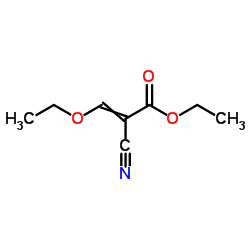

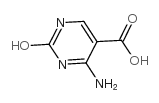


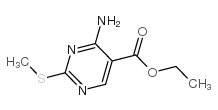
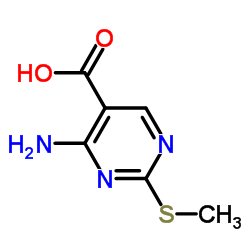
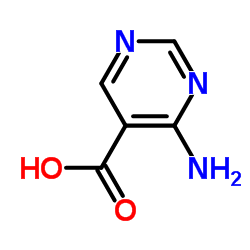
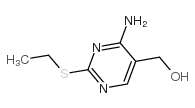
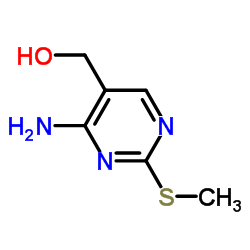

![{[4-AMINO-5-(ETHOXYCARBONYL)PYRIMIDIN-2-YL]THIO}ACETIC ACID structure](https://image.chemsrc.com/caspic/001/115102-54-0.png)